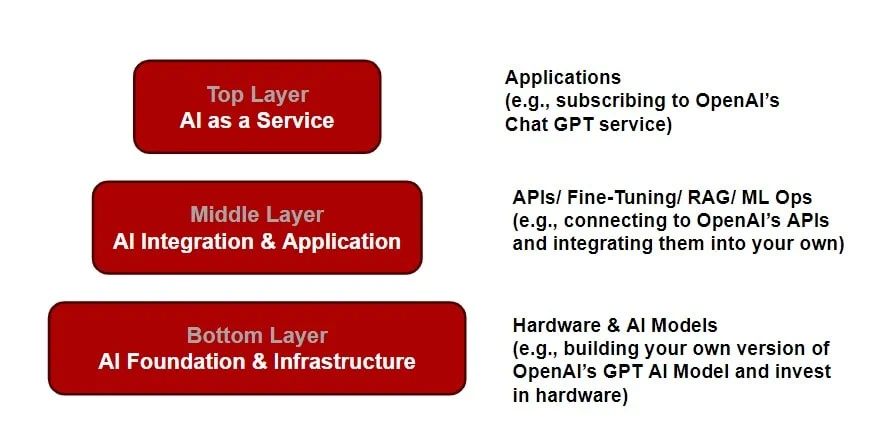
Artificial Intelligence (AI) has become a buzzword in the business world, promising transformative changes across various industries. However, understanding and adopting AI can seem daunting, especially for those who are new to the field. In this post, we will simplify the complexities of AI adoption and provide a clear roadmap for businesses looking to leverage AI technologies.
The Three Layers of AI Adoption
At its core, AI adoption can be broken down into three distinct layers, each representing a different level of commitment and technical involvement. This framework is particularly useful for business leaders who are considering AI adoption but may not have a deep technical background.

1. AI Foundation and Infrastructure
The bottom layer, the AI foundation and infrastructure, is the most fundamental. This is where businesses build or develop their own AI models and invest in the necessary hardware. An example is hiring a team to create a version of OpenAI’s GPT AI model from scratch. This approach requires a significant investment in skilled labor and advanced technical expertise. Businesses opting for this layer are typically looking for highly customized AI solutions that are tailored to their specific needs.
2. AI Integration and Application
The middle layer involves AI integration and application. This is where terms like APIs (Application Programming Interfaces), RAG (Retrieval Augmented Generation), and MLOps (Machine Learning Operations) come into play. At this level, businesses utilize existing AI models and enhance them for better efficiency and outcomes specific to their operations. For example, a company might integrate OpenAI’s APIs into their systems, leveraging the power of established models while making adjustments to better serve their unique requirements.
3. AI as a Service
The top layer is AI as a Service, which includes applications and Software as a Service (SaaS) models. Here, businesses subscribe to existing AI services, like OpenAI’s ChatGPT. This approach is the least burdensome in terms of cost and required skill level. It’s ideal for companies whose core competencies do not include AI but still wish to leverage its benefits. This could include, for instance, an oil and gas company looking to improve its marketing content using AI without divulging sensitive data.
Cost and Time-to-Value Considerations
Understanding the cost implications and time-to-value is crucial in making an informed decision about AI adoption. As we move down from the top layer to the foundation layer, the cost increases significantly. This is not just in terms of service costs but also labor and expertise. Building your AI infrastructure from scratch involves hiring a highly skilled team, which is a substantial investment.
Similarly, the time to derive value from these investments also varies by layer. Investing in the foundational layer can take months to years to build the necessary infrastructure. The middle layer offers a quicker turnaround, with weeks to months, and the top layer can deliver value in days to weeks.
Prioritizing AI Adoption
When it comes to prioritizing AI adoption, the general strategy is to start at the top and only move downwards when necessary. For example, if handling sensitive information that cannot be entrusted to third-party services, building your own AI infrastructure might be necessary. However, for functions that are not core competencies or don’t involve sensitive data, using AI as a service is often the most efficient approach. It simplifies processes and offers flexibility in terms of switching providers or discontinuing the service.
Making the Right Choice for Your Business
The decision to adopt AI at any of these layers depends largely on your business needs and core competencies. If your business revolves around highly sensitive data or requires highly customized AI solutions, investing in the foundational layer might be worthwhile. For those needing more tailored solutions than what AI as a Service can provide but do not require full-scale model development, the middle layer is appropriate. And, for businesses seeking to leverage AI benefits without significant investments in time or resources, AI as a Service is the most suitable option.
If you’d like to learn more, check out my “Generative AI for Business Leaders” course on Udemy or my “Generative AI for Busy Business Leaders” book on Amazon.
